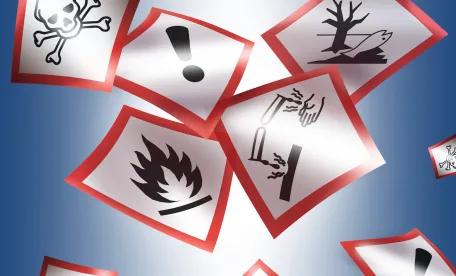On June 8, 2020, the Administrator of the U.S. Environmental Protection Agency (EPA) signed a final rule to “modernize” the ignitability characteristic under the Resource Conservation and Recovery Act (RCRA), which is one of the methods used to determine when solid wastes must be managed as hazardous wastes under federal law (and, with limited variations, the law of all states). While the 2019 proposed rule would have made several substantive changes to the characteristic that could have significantly expanded the scope of the hazardous waste program, EPA backed away from most such changes in the final rule. The final rule instead makes mostly technical changes to the characteristic, although the preamble includes guidance that may be more significant.
The final rule will take effect, as a matter of federal law, 60 days after it appears in the Federal Register. However, as discussed further below, it will take much longer for the rule to take effect in most states.
Background
Under the RCRA regulations, solid wastes are classified and regulated as hazardous wastes if they are explicitly listed as such or if they exhibit a “characteristic” property of hazardous waste. See 40 C.F.R. § 261.3(a)(2). One such characteristic is the ignitability characteristic, which has different criteria for classifying wastes as hazardous, depending on whether they are solids, liquids, or gases. Of particular importance here, liquids are defined as ignitable hazardous wastes if they have flash points below 60°C (140°F) – unless they are aqueous liquids with less than 24% alcohol. See 40 C.F.R. § 261.21(a).
On April 2, 2019, EPA proposed several changes to the ignitability characteristic. See 84 Fed. Reg. 12,539. A detailed summary and analysis of this proposal can be found here. In short, the proposal would have done the following:
-
Narrowed the exclusion for aqueous liquids with less than 24% alcohol;
-
Established new rules for “multiphase mixtures” (i.e., wastes consisting of solids and liquids and/or more than two immiscible liquids); and
-
Made several technical changes to the characteristic.
As discussed below, EPA finalized the third element of the proposal. Although the Agency did not finalize the other two elements, its discussion of these elements provides guidance that may prove to be important.
Final Action on the Aqueous Alcohol Exclusion
In the 2019 proposed rule, EPA expressed concern that the aqueous alcohol exclusion – which was established to ensure that wastes that had low flashpoints but posed minimal risks, because they did not sustain combustion, were not classified as hazardous wastes – was overly broad. To address this perceived problem, the Agency proposed and/or requested comment on a number of potential changes to the exclusion, such as limiting it to specific wastes (e.g., beer, wine, and latex paint), restricting the availability of the exclusion for certain types of alcohols, or requiring that excluded wastes contain a minimum amount of alcohol. These changes could have narrowed the exclusion significantly, and thereby significantly expanded the scope of the RCRA hazardous waste regulatory program.
In the final rule, EPA decided not to make any of these changes, saying that they required further discussion, analysis, and public input. The one change the Agency did make was to modify the exclusion so that it now applies to “solution[s] containing … at least 50 percent water by weight” – rather than “aqueous solutions” – that contain less than 24% alcohol. This change is consistent with long-standing EPA guidance on the meaning of an “aqueous solution” and thus arguably is not a substantive change to the regulations. The preamble to the rule also confirmed other past guidance on the scope of the exclusion. However, it broke some new ground, for example saying that if “[an] aqueous liquid waste contains almost no alcohol,” it would not generally be considered eligible for the exclusion.
Final Action on Multiphase Wastes
As noted above, the ignitability characteristic has different criteria for identifying ignitable solids, liquids, and gases. In the 2019 proposal, EPA proposed new provisions for multiphase wastes. Under these provisions, each phase of a multiphase waste would have to be evaluated separately, and if any phase met the relevant ignitable criteria (e.g., for solid or liquids), the entire waste would have to be classified as hazardous. This separate evaluation would have to be performed if the phases separated at any point during management (even if there was only one phase at the point of generation) or if it was “practicable” to separate phases in a laboratory (e.g., using an aggressive pressure filtration procedure).
Commenters on EPA’s proposal expressed concern that these provisions were unlawful since they focused on parts of the wastes, rather than the relevant issue under the statutory definition of hazardous waste, i.e., whether the wastes as a whole pose a significant risk to human health or the environment. They noted that the proposed provisions might capture wastes that do not separate under foreseeable management conditions, and/or that yield only minute amounts of ignitable liquids that do not cause the wastes as a whole to pose a genuine fire hazard.
In response to the comments, EPA decided not to finalize its proposal on multiphase wastes. Instead, it built on prior guidance to explain the Agency’s position on the status of multiphase wastes. Among the key points EPA makes in the preamble discussion are the following:
-
Generators should “consider” evaluating the individual phases of a waste if any of the phases might cause the entire waste to pose a fire hazard at any point during management of the waste.
-
In determining whether a solid waste contains liquids that might warrant separate evaluation, it is generally sufficient to see whether any liquid drips from the waste under the Paint Filter Liquids Test. However, in some cases (unclear exactly when), pressure separation may be needed to accurately characterize the wastes.
-
Manufactured articles with minute amounts of liquids (possibly including batteries with ignitable electrolytes and mechanical devices with ignitable lubricating oils) are “likely” not ignitable if they do not yield liquids under the Paint Filter Liquids Test.
Some parts of the guidance in the preamble may be helpful, while others may raise more questions than they resolve.
Technical Changes to the Characteristic
The final rule makes a number of technical changes to the RCRA ignitability characteristic. For example, it allows the use of alternative test methods for determining the flashpoints of liquids (e.g., methods that use non-mercury temperature measuring devices, electric spark ignition sources (rather than flame ignition sources), and automated instrumentation). In addition, the final rule modifies the criteria for ignitable compressed gases and oxidizers to track the corresponding definitions in the U.S. Department of Transportation (DOT) Hazardous Materials Regulations more closely.
Effect in the States
Virtually all states have their own hazardous waste regulatory programs and have been authorized by EPA to implement substantial portions of such programs in lieu of the corresponding portions of the federal RCRA program. In the preamble to the final rule, EPA acknowledges that the changes to the ignitability characteristic will not take effect in such authorized states unless and until the states adopt the changes. The Agency further states that, because the changes are “neither more nor less stringent” than the pre-existing rules, states will not be required to adopt the changes. Nevertheless, because of the technical nature of the final rule, it seems likely that states will gradually adopt the new rule over time.




 />i
/>i

